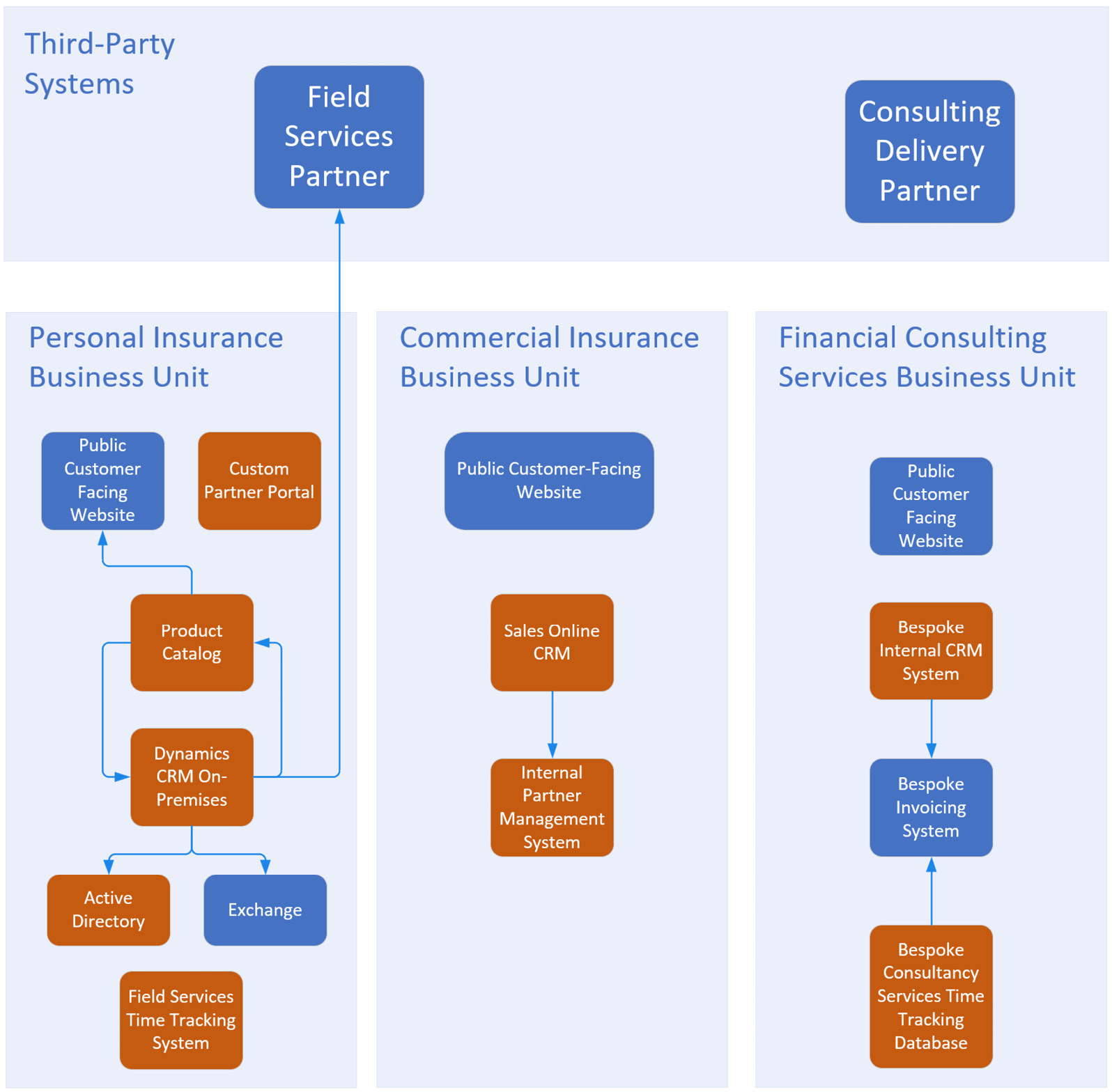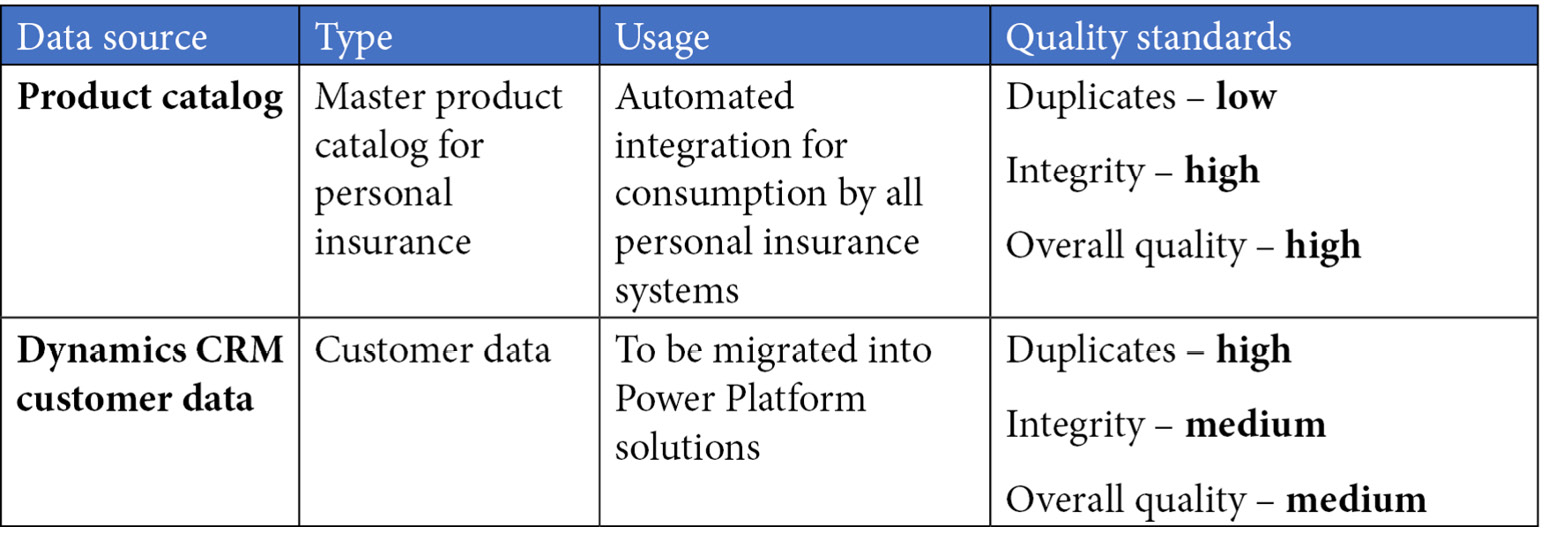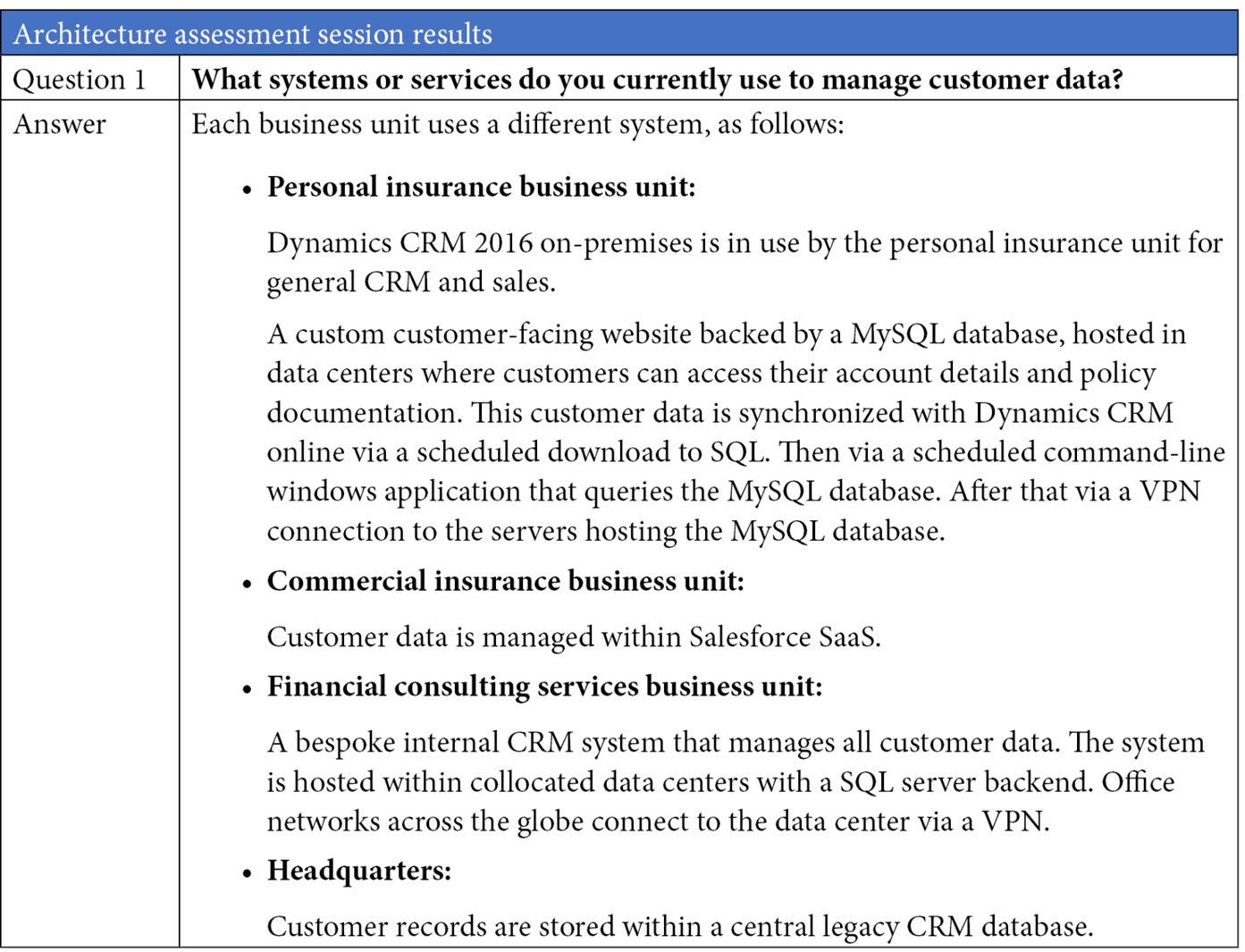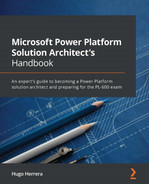Chapter 5: Understanding the Existing Architectural Landscape
In this chapter, you will assess the data sources and architectural landscape at Inveriance Corps, gaining a deep understanding of the starting point for the digital transformation project. You will learn to evaluate the overall enterprise architecture, the current sources of data, and their locations and use cases. You will then document the current architecture and data models to cement that understanding and facilitate the requirement-capture conversation.
In this chapter, we are going to cover the following main topics:
- Assessing the existing enterprise architecture
- Identifying existing sources of data, their usage, and quality standards
- Documenting the organization’s architecture and detailed business processes
Understanding the existing architectural landscape and business processes is an important first step on the way to defining the target architecture. Decisions made during the design process will consider the current architecture.
Assessing the existing enterprise architecture
Enterprise architecture models represent a business’s structure and the relationships between its various domains. The domains include physical, organizational, and technical components. A full enterprise architecture discussion is beyond the scope of this book. We can, however, draw value from a baseline analysis.
An evaluation of the current enterprise architecture provides perspective, which you can use to decide where Power Platform best fits within an organization. Solution architects assess the baseline architecture and draft the proposed model that considers the enterprise architecture roadmap for the organization. With the plan in hand, you have an effective high-level directive, allowing you to focus project activities on getting from the as-is situation to the to-be end state.
Understanding the current enterprise architecture
To start the evaluation of the current enterprise architecture, you would ask the following questions:
- What are the current pain points and known open issues within the enterprise?
- What inconsistencies exist in the way the enterprise performs its functions?
- What quality issues have been identified within the organization?
The answers to these questions will help you gain an understanding of where the business is seeking to find solutions to long-standing problems or pain points, and where Power Platform can solve those problems.
Understanding the upcoming changes that may have an impact on the enterprise architecture
Organizations are ever-evolving and changing. While evaluating the as-is state of an enterprise, having visibility of what change is around the corner will help you strategically place Power Platform to provide long-term solutions to upcoming challenges brought about by change.
The following types of questions will help you gain an understanding of the potential changes that may impact the enterprise architecture:
- Is any new business or technical infrastructure being introduced in the future that will have a material impact on the enterprise architecture?
- What new business processes or significant technical functionality do you plan to bring into the organization, both short- and long-term?
- What operational changes can take place that will impact the enterprise architecture?
The answers to these questions will help make architectural decisions that will guide the Power Platform implementation to continue providing value to an organization, if and when these potential changes occur.
Understanding the desired enterprise architecture
Once you understand the current environment and potential impacting changes, you can start drafting a model for the desired enterprise architecture, typically involving the following activities.
- Drawing an enterprise architecture roadmap for the areas that relate to Power Platform and the Microsoft stack
- Proposing options for desired architecture together with a trade-off analysis, comparing each option to identify the best fit for the organization
Understanding the current enterprise architecture, potential changes, and the desired state, you have an achievable roadmap that will help you select the right Power Platform blueprint and implementation strategy to meet an organization’s needs head-on.
Identifying Power Platform data sources, their usage, and quality standards
Power Platform applications can consume data from a wide range of sources. Identifying these data sources provides an early view of how data will be fed in and out of Power Platform and how it will be consumed. We can also find out about any data cleansing or normalization that may be required. This exercise will be illustrated using our case study at Inveriance Corps.
Case study – current data sources at Inveriance Corps
Having reviewed the high-level architecture diagram drafted during the discovery phase, several key data sources have been identified and are highlighted in the following diagram:

Figure 5.1 – Key data sources at Inveriance Corps
Having identified the key data sources to be used as part of the Power Platform implementation, you can now define their usage. Data sources may be imported into Power Platform as a one-off migration process, integrated in real time, or scheduled for synchronization. The initial data usage analysis provides insights into how data is currently used.
A rough benchmark for data quality is also set based on discussions and a review of data samples where appropriate. The estimated number of duplicate records, the referential integrity of the data, and the overall data hygiene are identified for each data source. The following table lists a few of the key data sources, their usage, and quality standards:

Table 5.1 – Key data sources, their usage, and quality standards at Inveriance Corps
The complete data source assessment provides a base for the requirement-capture discussions that are to follow.
Documenting the organization’s architecture and detailed business processes
The output from the activities in the enterprise architecture assessment section in this chapter provides a baseline understanding of the systems in place at an organization. You can then extend this understanding into architectural diagrams and documentation that will facilitate the upcoming design process.
The answers to the following questions will help you to gain an understanding of systems architecture within an organization.
- What systems or services do you currently use to do the following?
- Manage customer data
- Manage staff members and their access to systems
- Send and receive emails
- Message and collaborate between staff, vendors, and other third parties
- Where are these systems or services hosted?
- How do staff members access these systems or services?
- What systems or services do your customers use to interact with your organization?
- What systems do partners and third-party organizations use to interact with your organization?
- What infrastructure do you have in place for managing integrations or messaging between systems?
The preceding sample questions are a conversation starter that will lead to more detailed discussions on each topic and result in a greater understanding of the existing architecture. The next step is to translate these discussions into diagrams and supporting documentation that illustrates the architecture and facilitates the upcoming dialogue design and implementation activities.
Using our case study at Inveriance Corps, you will learn to translate the results of these questions into an architectural blueprint.
Case study – assessing the existing architecture at Inveriance Corps
Through several workshops and analysis sessions with the owners of the relevant systems and SMEs at Inveriance Corps, you have gained an understanding of the organization’s existing architecture through the following Q&A session:


Table 5.2 – Architecture assessment session results
Based on these answers and further detailed dialogue into each of the architectural areas, we can draw a model of the current solution architecture at Inveriance Corps:

Figure 5.2 – The systems architecture overview at Inveriance Corps
A systems architecture diagram is a key document that provides a clear understanding of the systems in place and their interactions. The diagram will be refined during the design phase to illustrate how the current architecture will change once the Power Platform project is underway.
An architecture assessment summary
The architecture is primarily hosted within on-premises systems and collocated data centers. A substantial portion of systems are custom-built and require considerable ongoing maintenance. Multiple separate customer databases have resulted in data silos that are integrated manually with the central headquarters’ customer database.
Assessing the current organization’s architecture provides a window through which we can look at multiple possible routes for implementing and integrating Power Platform components and related Microsoft services.
Summary
In this chapter, you have learned how to assess the current architectural landscape, identify the key data sources and quality standards, and draw up documentation for the current system’s architecture. These key data points provide the basis for a fruitful discussion during requirement-capture sessions that will follow.
In the next chapter, you will start the requirements analysis and engineering stages by refining the digital transformation goals and identifying functional and non-functional requirements.
